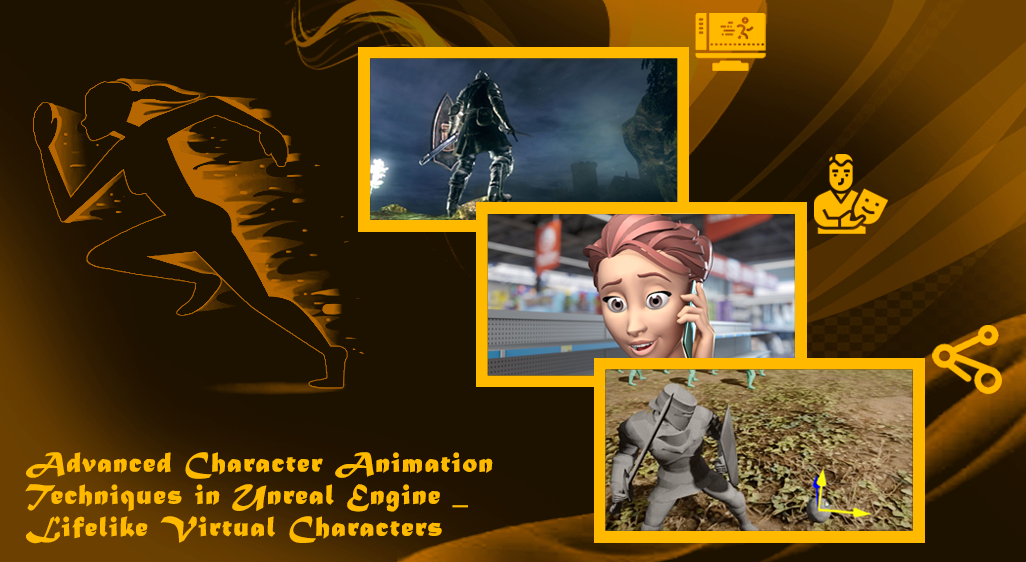Advanced character animation is a fundamental aspect of creating immersive and engaging gameplay experiences. In the world of game development, Unreal Engine stands out as a powerful tool for crafting lifelike characters. In this blog, we will explore advanced character animation techniques in Unreal Engine, delving into topics such as skeletal animation, blend spaces, animation blueprints, facial animation, full-body IK (Inverse Kinematics), optimization, and more. By the end, you will have a solid understanding of the tools and methods used to breathe life into virtual characters, enabling you to create captivating and realistic animations for your games.
The Basics of Character Animation in Unreal Engine
A key aspect of game creation is character animation, and Unreal Engine offers powerful tools and capabilities to make virtual characters come to life. Character animation in Unreal Engine is centered on the skeletal animation system. It entails building a hierarchical bone framework that controls character movement. In this process, the bones are set up through rigging, and the mesh of the character is attached to the bones through skinning. Animations can be produced and loaded into Unreal Engine once the character has been rigged and skinned. Before beginning to use more complex strategies, it is essential to comprehend these basic ideas.
Building Realistic Movement with Animation Blending
For immersive gameplay experiences, character movements must be smooth and realistic. Strong animation blending algorithms provided by Unreal Engine provide smooth transitions between various animations. Blend spaces, which interpolate between animation states based on input parameters, are essential for creating fluid movement. For instance, a blend space can be used to regulate a character’s direction and speed of movement. Animation montages also make it possible to combine many animations to produce complicated and dynamic character actions. The use of blend spaces, animation montages, and methods for generating realistic movement, combat animations, and interactive movements within the game environment will all be covered in this part.
Creating Dynamic and Expressive Characters with Animation Blueprints
Character animations can be managed visually with the use of animation blueprints in Unreal Engine. By blending, controlling, and combining animation sequences, animation blueprints make it possible for characters to behave in complex and responsive manners. The Animation Blueprint graph gives a visual representation of the execution and control of animations. Different animation states can be defined with the help of state machines, and transitions between states can be managed according to predetermined criteria. Developers may design dynamic and engaging character animations using animation blueprints, which improves the overall gameplay experience. You may get started with designing and managing character animations with Animation Blueprints by following the step-by-step instructions and real-world examples in this area.
Advanced Techniques for Facial Animation
Facial animation plays a crucial role in conveying emotions and bringing characters to life. Unreal Engine offers various techniques for achieving realistic facial animations. One method is through morph target animation, also known as blend shapes, where different facial expressions are stored as targets and can be blended based on various factors such as emotions or speech. Another approach is bone-based facial rigging, where bones are placed on the face to control the movement of different facial features. Unreal Engine provides tools and controls to manipulate and animate these facial rigs effectively. Using this process create expressive and nuanced facial animations that enhance the believability of virtual characters. Additionally, lip-syncing techniques also help to synchronize character dialogue with facial animations, adding another layer of realism to your game.
Implementing Full Body IK (Inverse Kinematics)
Full Body IK is a powerful technique that allows characters to interact dynamically with the environment. It enables characters to respond realistically to the game world by dynamically adjusting their posture and positioning. In Unreal Engine, Full Body IK can be implemented using the IK system, which calculates the position and orientation of character bones based on constraints and targets. This technique is commonly used for tasks such as foot placement, where the character’s feet should accurately follow the terrain, or for adjusting body posture to interact with objects or other characters. Delve into the implementation of Full Body IK in Unreal Engine, covering techniques for handling IK constraints, foot placement, and body posture adjustments. By incorporating Full Body IK, game developers can create immersive and realistic character interactions within the game world. Practical examples and guidelines for implementing Full Body IK in Unreal Engine will be provided.
Optimizing Performance and Memory Usage
Character animations can consume significant computational resources, impacting game performance and memory usage. Therefore, optimizing performance and memory usage is crucial for delivering smooth gameplay experiences. In this section, we will explore strategies for optimizing character animations in Unreal Engine. Level of Detail (LOD) systems can be implemented to reduce the complexity of character animations based on distance, improving performance by using simpler animations for distant characters. Animation compression techniques can be applied to reduce the memory footprint of animation data without sacrificing quality. Skeletal mesh optimization can be employed to streamline the rendering process by reducing the number of vertices and bones in the character’s mesh. These optimization techniques ensure smooth and efficient character animations without compromising quality.
Mastering advanced character animation techniques in Unreal Engine empowers game developers to create captivating and realistic virtual characters. By leveraging the tools and methods discussed in this blog, you can breathe life into your game’s characters, enhancing immersion and engagement. Remember that practice, experimentation, and continuous learning are key to refining your character animation skills. Unreal Engine provides a robust platform for unleashing your creativity and creating truly lifelike characters that will captivate players and elevate your game to new heights. Learn game designing on Unreal Engine from the best animation institute in Kolkata.












